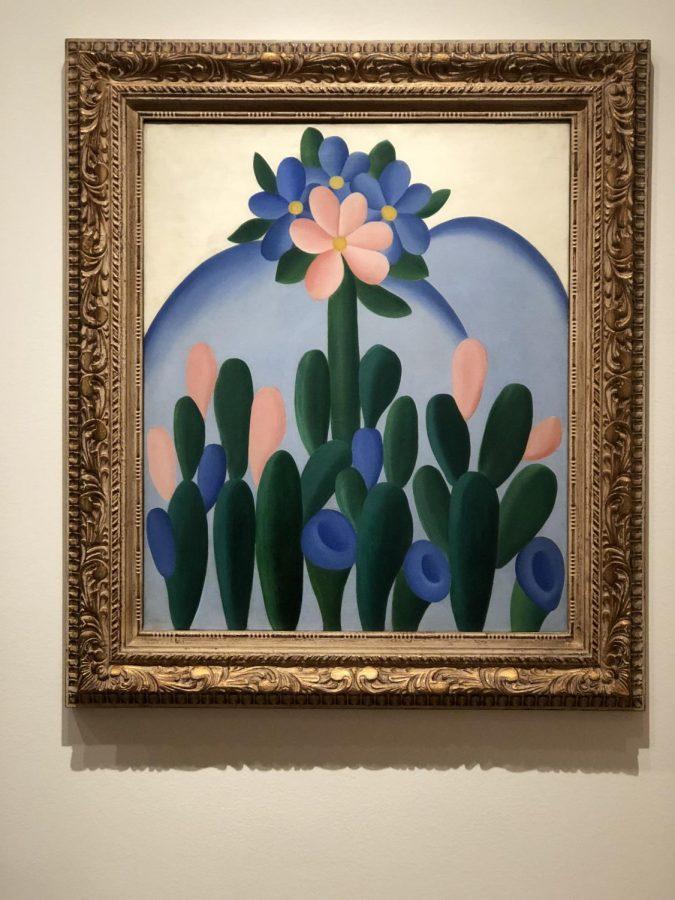MoMA Welcomes Paintings by Tarsila do Amaral
“Manacá” (1927) by Brazilian painter Tarsila do Amaral displayed in MoMA.
February 12, 2018
Brazilian painter Tarsila do Amaral was born in São Paulo, where she studied piano, sculpture and drawing. In 1920, she moved to Paris to study at Académie Julian, a private art school for painting and sculpture.
An exhibit focusing on Amaral’s life and career, “Tarsila do Amaral: Inventing Modern Art in Brazil,” opened at the Museum of Modern Art on Feb. 11.
This exhibition focuses on her famous work beginning in the 1920s, during which she was a part of both the São Paulo and Paris art spheres. Amaral played a critical role in the emergence of modernism in Brazilian art.
With her artwork, Amaral aimed to represent common themes of Brazilian culture. Themes in her pieces include bright colors, clean lines and bold shapes.
Elenne Carroll and Grace Steite, MoMA members who attended a special after hours preview of the exhibit, expressed how they were impressed by Amaral’s use of colors and were especially drawn to her piece “O Lago” (1928).
One piece that reflected these themes was “Manacá” (1927). This oil on canvas painting gets its name from the manacá flower, which is found in Amazonian regions and is native to Brazil. The bright purple and pink flower is painted beautiful with simple and clean lines. The shape of each petal is rounded perfectly, and the stem of the flower resembles a cactus. This piece reflects the importance of nature and bright colors in Amaral’s work, as she aimed to express themes native to Brazil.
The theme of nature in Amaral’s pieces did not go unnoticed by Tracy Boachie, another spectator of the exhibit during a preview event.
“I really like the depiction of nature; that’s what I’m paying attention to as I’m going through this exhibition,” Boachie said.
Amaral had a vital involvement in an artistic movement inspired by the Manifesto of Anthropophagy, or the Cannibal Manifesto. Inspired by her piece “Abaporu” (1928), Amaral’s husband Oswald de Andrade transformed the motif of cannibalism into a symbol for taking in or “ingesting” European art into his practice. He wanted to create a new style of art that was unique to Brazil. “Abaporu” became the face of the movement, as the title means “a man who eats human flesh.”
“Abaporu,” is featured in this exhibit along with sketches of the work in ink. It is fascinating to see the original versions of such a significant piece of art, and the process in which Amaral reached her final version which led a movement.
MoMA employee Justin Nissley eplained that Amaral’s work was monumental because of her take on cubism and surrealism.
“She was using elements of cubism and surrealism,” Nissley said. “She’s using her voice, the Brazilian voice, with the tools of surrealism and cubism.”
Later in Amaral’s career, she moved from general themes of Brazilian culture to a focus on political activism. This change is specifically reflected in her work “Operários” (1933). The coloring is darker than her other pieces, the lines are less sharp and the faces are more detailed. Her other pieces include simple shapes and less detailed faces and people. This piece leans away from the cubism, and toward a more lifelike depiction of the people portrayed.
This exhibit is a must-see. Amaral is an important modern Latin American artist, who deserves more exposure in the United States The art pieces are bright and colorful and evoke happiness, while also urging spectators to think about serious issues and delve into Brazilian culture. This exhibit is an educational experience, from learning about anthropophagy to learning about basic imagery found throughout Brazil; it is phenomenal.
“I think it’s important to have her shown here, [as an example of providing] exposure for female artists who haven’t had a lot of exposure,“ Nissley said.
A version of this article appeared in the Feb. 12 print edition.
Email Eugenia Cardinale at [email protected].
























































































































































